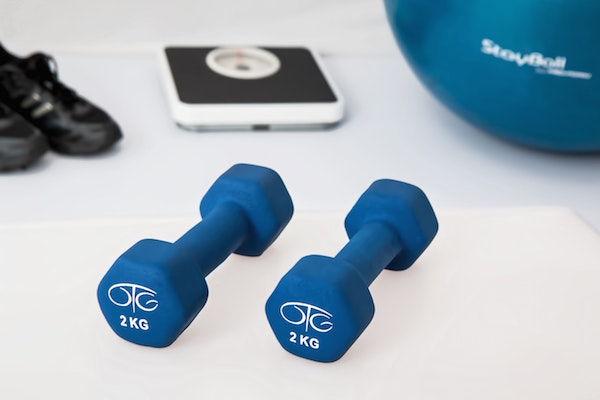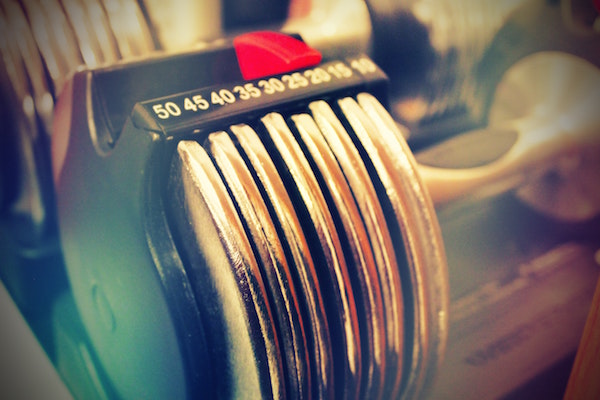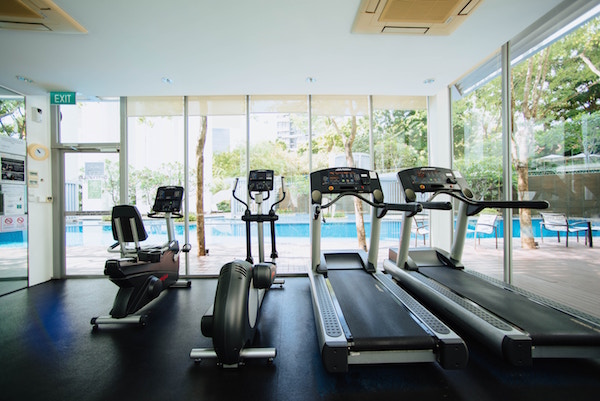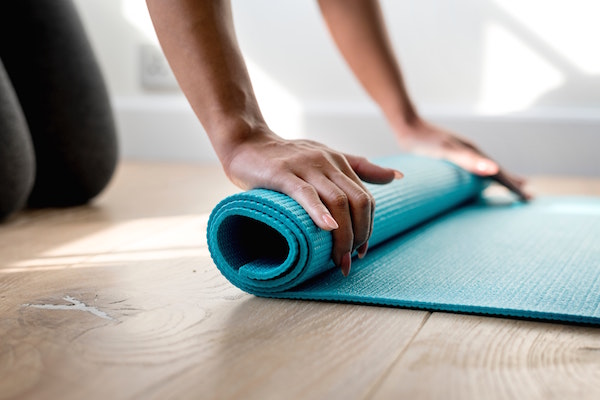
Who needs a gym when you can work out at home?
There are some great benefits of working out in the comfort of your house or apartment (especially when you’re first starting out).
The biggest one being: It’s free!
All you need is some basic equipment to get started instead of paying hefty gym membership prices.
But what’s the best home exercise equipment for beginners to buy?
For my money, I think it’s best to keep it simple and bare bones when you’re just getting started working out at home.
You’ll just need:
- Dumbbells & a weight bench (to build strength)
- A treadmill or stationary bike (for cardio)
- And/or a yoga mat (for yoga and other mobility work)
Seriously. That’s it.
Let’s take a closer look at why I think you only need those few things, and my top picks if you’re ready to buy for your home gym soon.
Why working out at home is great for beginners
There are a few reasons I’d recommend starting with a simple home workout routine if you’re a complete newbie:
Cost
Convenience gyms like Planet Fitness are pretty inexpensive, but over time the membership fees can really stack up.
(Slightly nicer and more robust gyms can run you $500 per year or more in dues.)
At the beginning of your fitness journey, you don’t really know yet if you’ll stick with it for the long haul.
Everyone thinks they will, but until you actually start to love it and make working out a habit over the course of months and months, you might not want to lock yourself into a commitment.
You might argue that the gym contract will motivate you to keep going — I’d argue that there are tons of people who let their gym memberships waste away idly for months or years. They’re literally throwing money away.
If I were just starting fresh today, I’d make a small investment in some basic home equipment and see if I could “earn” the confidence to join a nice gym for the long term.
The gym can be really intimidating
Gym-timidation. It’s real.
When you’ve been going to the gym for a while, you start to realize that hardly anyone there really knows what they’re doing. But when you’re first starting out? Everyone around you looks like a super-fit expert, and you’re embarrassed to even be in their presence.
This is ESPECIALLY true of lifting weights. Strength machines and power racks can be confusing to set up and use at first, and being surrounded by meatheads while fumbling with them can really turn people off from commercial gyms.
It’s a good thing to build up a little confidence (and your physique) before joining a commercial gym. Though, of course, if you feel ready right away, you go for it — everyone has an equal right to be there.
Convenience (no excuses)
When you’re trying to get into the habit of working out, it’s SO easy to come up with excuses for why you can’t get to the gym.
Work, babies, chores, stress, you name it.
They might all even be perfectly valid. (Someone once told me “The best excuses are true.” But they’re still excuses.)
When you’ve got a set of dumbbells or a treadmill sitting in the garage, there’s literally NO excuse not to find even 15 minutes a few times per week to get a basic sweat going.
None. Zip. Nada.
In the early stages, just showing up and getting the workout done consistently is a HUGE win and will help you build the habit for life.
Now let’s take a look at the bare-bones equipment I think beginners should think about buying for working out at home:
To build strength: Get dumbbells & a weight bench

You don’t need a fancy $1200 machine to get in a good strength workout at home.
A good set up dumbbells or adjustable dumbbells will be all you need for a long time as you’re getting started building strength.
Dumbbells are fantastic because:
- They don’t take up much room
- They’re relatively inexpensive (compared to machines)
- They’re INCREDIBLY versatile
Seriously, they are SO versatile. Think about everything you can do with just some basic dumbbells:
- Curls & hammer curls (biceps)
- Kickbacks & skullcrushers (triceps)
- Bench & incline press (chest, shoulders, tricep)
- Shoulder press (shoulders, triceps)
- Rows (biceps, back)
- Upright rows (Shoulders, traps)
- And more and more and more
To make them even more versatile and useful, I’d add an adjustable weight bench to go with them so you can do bench and incline work, as well.
I’d also go with an adjustable dumbbell vs individual dumbbells — they’re great for saving space and money, and should last you for a pretty long time before you max them out.
For beginners just starting out, I’d highly recommend:
- The BowFlex SelectTech 552 dumbbells (Amazon link)
- And the Xmark flat incline decline weight bench (Amazon link)
Alternatively, you can do awesome stuff with kettlebells if you’re into more explosive and athletic-style strength training.
Here’s a great starter set of kettlebells on Amazon.
Eventually you might work your way up to wanting a full barbell set up with a power rack or squat rack, but for the time being, two adjustable dumbbells that go up to about 50 pounds per hand should keep you VERY busy.
(You can also check out my guides to picking weight benches and dumbbells for beginners.)
To burn calories & build endurance: Get a treadmill or bike

If strength training isn’t really your thing, or you want to supplement it with a good calorie burn now and then, definitely get yourself a good treadmill or stationary bike.
You don’t necessarily need cardio equipment — you can always go for a run or walk outside.
But it’s ultra convenient to have it in your home if you have the budget. Here’s why:
- Burn calories rain or shine
- Squeeze in a workout late at night when it’s not safe to go out alone
- Do high-intensity training, HIIT, or sprints
- Watch TV or read while you workout
So how do you decide between a treadmill and a recumbent or upright bike?
Here’s the deal.
Get a treadmill if you:
- Have extra space and a higher budget
- Care about running & speed performance
- Like to emulate long walks on an incline
- Can handle the impact from running in your feet, shins, and knees
On the other hand, I’d opt for a bike if you:
- Prefer low impact exercise
- Have no desire to improve your real-life running performance
- Have less room in your home or apartment
(Why not ellipticals? Well, ellipticals are a great workout, but the best ones are pretty large and difficult to fit into your home. They’re also a bit pricier than treadmills and bikes, on average.)
My favorite treadmill that I always recommend to people of all skill levels is the NordicTrack C 990 (Amazon link) — probably the best moderately priced treadmill you can find anywhere.
As far as bikes go, I’d go with an upright-style bike like the Sunny Health and Fitness Pro Indoor Cycling Bike (Amazon link) — it’s amazingly affordable and one of the best choices for HIIT workouts and fast calorie burns.
To promote mobility & practice yoga: Get a yoga mat

Yoga classes really have an amazing vibe, and they can give you a fantastic workout.
But DAMN are they expensive.
If you’re just wanting to try yoga out (or stretching and mobility work), doing so from home is a great option for beginners.
(You’d be AMAZED how many free guided yoga workouts you can find on YouTube. Turn the lights down a bit, light some candles or diffuse some essential oils, and you can make your own little at-home yoga studio for free.)
The only thing you’ll really need is a good yoga mat.
Even if yoga isn’t your jam, you can still use a yoga mat for:
- Sit-ups & ab work
- Stretching
- Meditation
- Planks
- Pilates
- And more
It’s really hard to go wrong with the Manduka PRO Yoga and Pilates Mat (Amazon link) — the quality is insane and it’s one of the best mats around for hot yoga.
You could also choose to go with a full-size “exercise mat,” but those are often pretty big. Yoga mats can do all the same stuff and will roll up into a nice, neat package.
What NOT to buy for your home gym & workouts
So like I said, that’s pretty much it!
That’s about all most beginners will need to get an awesome workout at home.
Now let me quickly cover some things I 100% think you DON’T need, that seem to be on every other list like this:
Gimmicks
You know those weird things that are like, resistance bands with a bar that you wrap around your body? And supposedly it’s “an entire gym in a box”?
Yeah, don’t get that.
I’m not saying gimmicks like that don’t work or have no purpose (Heck, I even tried and kind of enjoyed the Simply Fit Board, but I don’t think beginners need one).
It’s just that I’m a believer in the 80/20 rule: 80% of your results will come from the basic fundamentals like:
- Eating the right food
- Increasing cardiovascular health & burning calories (cardio)
- Building strength (weights or yoga)
These weird gimmicky fitness gadgets might be cool to experiment with down the line if you want, but in the beginning, you should just learn how to do real workouts that have been proven over time to get results.
Exercise balls & Ab wheels or other contraptions
Same thing here.
I don’t think these things are useless — far from it!
I think sitting on an exercise ball from time to time in your office cubicle is a nice way to stay active at work. And there are lots of great exercise-ball specific movements that can crush your core.
I own an ab roller and use it occasionally, and it is a great burn for your abs.
But again, these things won’t and shouldn’t be the foundation of your home workouts.
They’re just add-ons you can try out once you’ve gotten the basics and the habits down.
Equipment that looks confusing or hard to use
You know what really works?
- Barbells
- Dumbbells
- Treadmills
- Bikes
- Ellipticals
When people try to get clever and recreate the wheel with “revolutionary” workout machines where you swivel and pull and twist all at the same time, the results usually don’t hold up.
The rule of thumb is: If it looks confusing or hard to use, you probably won’t use it regularly.
Basically, avoid anything invented by Chuck Norris.
Do-it-all home gym cable systems
I’m not against cable machines, not by a long shot.
They’re great for isolation exercises and interesting variations of classic movements.
But if you’re just starting out, I don’t believe that a machine should be the basis of your strength training.
You’ll get far better strength and muscle gains from using free weights and dumbbells.
If you’re building out a really robust home gym and you want the option to do some cable isolation work, go for it!
But beginners will be better off sticking with the basics.
Wrapping Up
Your job as a beginner is to simply learn how to work out, build a foundation of strength and endurance, and build the habit by practicing consistency.
To do that, you really just need one or two pieces of equipment you know you’ll use regularly
Again, my top choices would be:
- Adjustable dumbbells & an incline bench
- A treadmill or a stationary bike
- And/or a yoga mat
That’s it. Seriously!
Once you’ve built your foundation and are ready for something more advanced, you can join a commercial gym, buy a full home gym set up, or add-in some gimmicks and fun accessories to liven up your workouts.
But focus on the basics at first to see the best progress.
Hope this helps, everyone!